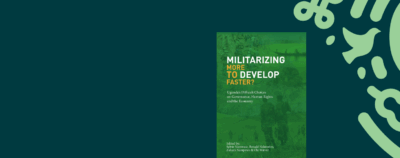“The life-insurance industry needs new vigor,” The Economist asserted in 2018. “Life insurers are struggling like never before,” read the subtitle. Life insurance is an old industry whose margins aren’t what they used to be. It needs to be “reinvigorated,” to be made “lively anew.” Death has become too predictable, too well quantified and sapped of value. Perhaps “The Undertaker’s Racket” has lost its luster after all.
“To better understand how the most marginalized, those who cannot afford to commodify their lives, manage the continued unpredictability of their deaths, we might turn the concept of ‘life insurance’ on its head.”The Economist’s statement reveals an unintended message: the delineation between lives that are valuable and insurable and lives that aren’t has become too predictable. To better understand how the most marginalized, those who cannot afford to commodify their lives, manage the continued unpredictability of their deaths, we might turn the concept of “life insurance” on its head. Approaching it as “death insurance” asks us to refocus more capaciously and think historically, with attention to how people must indemnify themselves against death in ways that move beyond the commodity, in spite of it, and with a recognition of its roots of social organization.
Through my research on the urban and political conditions of criminal organizations in Brazil, I will show how one community, the Primeiro Comando da Capital (PCC), has their own death insurance to not only mitigate the immediate vulnerability a fallen member’s family experiences but also to manage the social conditions that helped to create it: police violence, squalid prison conditions, and racialized precarity.
Caring for your own
Sometime in the latter half of 2012, a man affectionately named Teo worked a job on the outskirts of São Paulo. He was shot and severely wounded by police, ending up in the hospital for a number of days until his death not long after. Costs accumulated quickly, leaving his family untethered and struggling to pay for a dignified burial and support the futures of loved ones. Teo was one of 655 people killed by police that year—7 in 10 of whom were Black men. He had no life insurance policy, being both too poor and in too risky a line of work.
Instead, he had a different kind of life insurance, one that appreciated both his material conditions and the wrongfulness of his death—especially because of his line of work. Teo was an affiliate of the PCC, an organized crime group that emerged from a political economy of mass incarceration and violence.
In the PCC’s bureaucratic documents, which I’ve examined with a colleague at length,1Ben Lessing and Graham Denyer Willis, “Legitimacy in Criminal Governance: Managing Drug Empire from Behind Bars,” American Political Science Review 113, no. 2 (2019): 584–606. a bookkeeper writes of giving Teo’s “people” the total equivalent of $2,700 before and after his death, as a means of comfort and cost abatement. This is no paltry sum. It amounts to around nine times the value of the minimum monthly salary and more than 22 times the maximum monthly amount given to the very poorest by Brazil’s famed conditional cash transfer, the bolsa família.
Indeed, the PCC’s provision of “life insurance” to its people and their loved ones when they die exemplifies its broader organizational logic.
Death insurance’s community roots
Victorian industrialization gave the world many things: Cities as we know them in the West. Time as a question of hours, minutes, seconds. Scholars point, too, to the ways that industrialization also gave the world “life insurance” as it is widely understood today; the prepurchased and publicly traded ability to care for one’s loved ones, and oneself, after death.
From its earliest days in the United Kingdom, life insurance was made necessary by the industrial excessiveness of death and the vertiginous Victorian commodification of burial conditions.2 Princeton: Princeton University Press, 2015More Info → Together, these gave the problem of a breadwinner’s death a new kind of significance. Life insurance, better understood as death insurance, fantastically profits from the capitalist economy’s ability to commodify life through the breakdown of social ties and “mine” inequitably valued life, while maintaining conditions of inequality.
Princeton: Princeton University Press, 2015More Info → Together, these gave the problem of a breadwinner’s death a new kind of significance. Life insurance, better understood as death insurance, fantastically profits from the capitalist economy’s ability to commodify life through the breakdown of social ties and “mine” inequitably valued life, while maintaining conditions of inequality.
The incipient life insurance sector was very alive under this condition—The Economist would have loved it.3The ethical project now, following Foucault, is to make live, while letting die; to support lives that are worth it and to marginalize the deaths of others under guises of deservedness. Still, the life insurance industry relies on death, specifically on the ways that death has become predictable, calculable, and mitigated. It also requires the ongoing production of a fear of death, which must be read relative to the prohibitive and burdensome costs of life, and especially life that increasingly requires debt. “Whether it’s paying for university fees or making sure the mortgage can be covered,” says Barclays Bank on their website, “you can still support them if you die.”
The greater the specter of death, the larger the real or imagined cost of it falling upon you and those you leave behind, the greater the incentive for prospective policyholders to pay for protection against its deleterious effects. However, the everyday project of insuring people against ignominious death existed well before industrialization, in contexts where it couldn’t become a commodity, and through its denial of some lives as, ultimately, worth it.
In the face of death, in the twilight of political and legal regimes, particular kinds of shared identity emerged near the graveside, generating everyday justifications for the protection of vulnerable lives. Such forms are visible especially in moments, spaces and conditions where life insurance didn’t exist, where the risk was “too high,” or where it was simply denied to some populations. Whether we call them benevolent associations, chevra Kadisha, burial societies, or an immorality trust, all manner of “marginal” populations codified social organization and identity around a shared understanding of the problematic conditions of death. Newsboys in the industrializing United States buried their own.4Vincent DiGirolamo, “Newsboy Funerals: Tales of Sorrow and Solidarity in Urban America,” Journal of Social History 36, no. 1 (2002): 5–30. So, too, did Jewish traders in the nineteenth-century Atlantic, workers’ societies in Victorian England, and “taxi mafias” in apartheid South Africa.5→Charles Van Onselen, “Jewish Marginality in the Atlantic World: Organised Crime in the Era of the Great Migrations, 1880–1914,” South African Historical Journal 43, no. 1 (2000): 96–137.
→Leslie Bank, “The Making of the Qwaqwa ‘Mafia’? Patronage and Protection in the Migrant Taxi Business,” African Studies 49, no. 1 (1990): 71–93.
But to situate death insurance in hindsight is to imply that this kind of social organization isn’t a thing anymore. But ethnographers lucidly detail the ways street kids in our times and in places like Brazil and Mexico work to cobble together resources for dignified burials to avoid, as Kristen Drybread has shown, having their friends dumped in a mass grave or on a trash heap.6→Gareth Jones, Elsa Herrera, and Sarah Thomas de Benítez, “Tears, Trauma and Suicide: Everyday Violence among Street Youth in Puebla, Mexico,” Bulletin of Latin American Research 26, no. 4 (2007): 462–79.
→Kristen Drybread, “Social Life and the Deaths of Brazilian Street Children,” Journal of Latin American and Caribbean Anthropology 18, no. 2 (2013): 212–230. Katie Sobering and Javier Auyero hint, too, at the ways these kinds of practices continue to move through life on the margins, where people killed in wrongful ways are never buried without proper recognition.7Katie Sobering and Javier Auyero, The Ambivalent State: Police-Criminal Collusion at the Margins (Oxford: Oxford University Press, forthcoming).
Born from violence, required by precarity
In 1992, Brazilian police stormed into what they described as a prison riot at Carandiru Penitentiary. Soon after, 111 unarmed prisoners lay dead. A revealing image circulated in the aftermath, illuminating both prison politics and the everyday ethics of responsibility. Naked prisoners were made to lug the dead out of the cells and into the halls, wading through blood on the floor. The iconic photo, taken from behind one prisoner, holding a body by the feet, captures the banal political logic—let the poor, the prisoners, the peripheral, deal with the outcomes of Their death, Their violence, of Their “insurrection.” The state looks on, quite literally preparing to wash its hands, absolving itself.
One year later, the PCC was born in this prison, assuming responsibility for the conditions of life and death in the “seed and root” of the institution, scrawled in its Statute. Referencing the massacre, this group of prisoners promised to transform the prison system, becoming a social vestige of what they immortalized as “a massacre that will never be forgotten in the consciousness of Brazilian society.” The PCC has changed much since, institutionally. The debate now is not about whether a transformation of the prison system took place, but about how extensive it has been—and how to make sense of it conceptually as a result.8Jaime Alves, “‘Blood in Reasoning’: State Violence, Contested Territories and Black Criminal Agency in Urban Brazil,” Journal of Latin American Studies 48, no. 1 (2016): 61–87.
By its own words, the PCC is made up of os filhos da miséria, “the sons of poverty.” Since the group’s formation, São Paulo’s prison population has grown by greater than 400 percent and Brazil has the third largest prison population in the world. But the PCC did not stay a prison organization. Instead, it followed the process Loïc Wacquant describes as mass incarceration’s “deadly symbiosis”—the mundane flow of criminalized bodies from marginalized urban spaces to prisons and back again—establishing itself throughout the city, the state, and beyond.
Amidst this terrain, the PCC now operates through what it calls a “peace among criminals,”9São Paulo has since witnessed a homicide decline of over 85 percent since the early 2000s. that includes paying for family members to travel for visitation, while providing other things like a “social reintegration” program for parolees, guaranteeing both money and a gun for people who are materially barren on release.10Graham Denyer Willis, “The Gun Library,” Boston Review, April 8, 2014.
See, also, Karina Biondi, Sharing This Walk: An Ethnography of Prison Life and the PCC in Brazil (Durham, NC: University of North Carolina Press, 2016); Gabriel de Santis Feltran, “The Management of Violence on the São Paulo Periphery: The Repertoire of Normative Apparatus in the ‘PCC’ Era,” Vibrant – Virtual Brazilian Anthropology 7, no. 2 (2010): 109–134. The political economy of mass incarceration has taken on a life of its own, having become a necessary condition for PCC members’ survival: young men pay membership dues on the outside for when the time comes to go inside—itself a kind of insurance.
What the PCC did for Teo, it did out of this logic. And, even in the relatively limited documents that I have examined, it did it so for at least four others too, in just a part of São Paulo state. All of these expenses were tracked and accounted for in their own bureaucratic accounting documents,11These documents were given to me by an ethnographic counterpart in the public security system in 2013. which I reviewed while carrying out ethnographic research for my first book, The Killing Consensus, on homicide detectives. In it I illustrate some of the ways that homicide detectives decide when being killed by the police is right and when it is wrong, compelling them (against long odds) to call for the arrest of the officers responsible. The logic that I trace in the book—that state violence and its mitigated investigation shapes and reproduces a justification for the PCC, which has become “nested” within the state itself—makes clear why someone with limited choices might decide to join the organization in the first place.
When Marcos was shot and killed in “Quarrytown,” a peer member in the organization wrote a short note describing the circumstances in a document titled “deaths and losses”:
Marcos was done in during an operation where he was hit and injured he was in the hospital for a few days but died. The brothers from the city passed along that for a funeral to take place they need help because the family doesn’t have the conditions to do a burial.
The following month, in a separate document that accounts for the organization’s drugs sales, costs, and expenditures, I found a line between “360.00 for cost of car to take family members back home from visit to ‘XX’ prison” and “700.00 for Fred’s trip to the capital city.” It reads:
1,900 re: payment of funeral for our oldest brother from Quarrytown.12Graham Denyer Willis, “The Potter’s Field,” Comparative Studies in Society and History 60, no. 3 (2018): 539–568.
The PCC is just one example of social responses to violence, inequality, and death. It is an organization that both protects some people from violence while wielding it on others. It happens in highly masculine, heteronormative and in some very violent ways. Paradoxically, it is another way that people in São Paulo carry with them a sense of the fear of death in everyday life, allocating it to particular poor and racialized bodies that might make up the PCC—and come to rob them in the midst of their daily routines. The point is: the PCC, life insurance, and capitalism all work through fear.
But if the PCC gives members like Teo and Marcos a dignified burial, the importance of the story is not in the narrowness of a “pay out” or about what it means to be a member of a criminal organization. It is, I think, about those who will never join this organization, or another like it, and who similarly will never be able to afford or be worthy for life insurance.
Concluding thoughts
Deliberately turning away from the terminology of “life insurance” and what it enables politically allows for recognition of the ways death works unexceptionally and the giving of life works exceptionally—the inverse of what is commonly understood. To speak in terms of “life” polishes a liberal gloss that disavows the ways that violent death happens and matters in structural ways, creating new incentives and social demands as it goes. Death, and the fear of it, is a powerful generator of social organization.
“To think through death and to rigorously study its conditions is often framed as too pessimistic, beyond the pale, or depressing.”To think through death and to rigorously study its conditions is often framed as too pessimistic, beyond the pale, or depressing. Why not focus on the positives (!), on the iterative gains that have been made, and on deepening democracy? Won’t it make you go mad? I think this position misplaces both justice and optimism. A rigorous consideration of the conditions of death, and perhaps especially of its ongoing and perhaps increasing egregiousness, is to recognize the height of injustice in spite of gains for some. To pay attention to something like death insurance is to begin to reconstruct and imagine a just world where the protection and celebration of life does not operate though thin foils like a “life” insurance policy—and what is made necessary within the same conditions.
Banner photo credit: Raphael Tsavkko Garcia/Flickr
References:
→Leslie Bank, “The Making of the Qwaqwa ‘Mafia’? Patronage and Protection in the Migrant Taxi Business,” African Studies 49, no. 1 (1990): 71–93.
→Kristen Drybread, “Social Life and the Deaths of Brazilian Street Children,” Journal of Latin American and Caribbean Anthropology 18, no. 2 (2013): 212–230.
See, also, Karina Biondi, Sharing This Walk: An Ethnography of Prison Life and the PCC in Brazil (Durham, NC: University of North Carolina Press, 2016); Gabriel de Santis Feltran, “The Management of Violence on the São Paulo Periphery: The Repertoire of Normative Apparatus in the ‘PCC’ Era,” Vibrant – Virtual Brazilian Anthropology 7, no. 2 (2010): 109–134.














